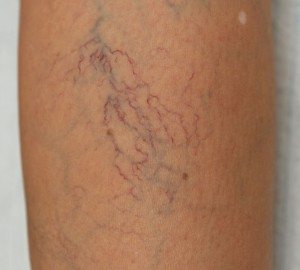Varicose Veins
Varicose veins are enlarged and twisted veins that commonly occur in the legs. They are caused by weakened or damaged valves within the veins, which hinder the normal flow of blood. Normally, these valves help ensure that blood flows upward from the legs toward the heart. However, when the valves become weak or damaged, blood can pool in the veins and cause them to stretch and bulge, resulting in the appearance of varicose veins. Varicose veins are often characterized by a blue or purple color and may be accompanied by symptoms such as pain, swelling, and a heavy or achy sensation in the legs.
Types of Varicose Veins
There are two types of varicose veins:
- Reticular Varicose Veins
Reticular varicose veins are smaller, bluish-green veins beneath the skin’s surface. They are milder than larger varicose veins but can still cause cosmetic concerns. Treatment options include lifestyle changes, compression stockings, and sclerotherapy. Seek medical advice for appropriate management.

- Spider veins
Spider veins, also known as telangiectasias, are small, dilated blood vessels near the surface of the skin. They appear as thin, red, or purple lines, resembling a spider’s web. While typically harmless, they can cause self-consciousness.

Symptoms & Diagnosis
Dull aching pain over ankle & Leg cramps
Swelling of feet
Non healing Ulcer over leg area
Blackening or discoloration over Leg
Itching & Eczema
Assessment of patient as per following
- Ultrasound Venous Colour Doppler
- CT venography for accurate diagnosis & Treatment Plan
Causes
- Obesity
- Pregnancy
- Prolonged standing Occupation
- Old Age
- Deep Vein thrombosis
Procedures
Various treatment options are available, ranging from lifestyle modifications and compression stockings to minimally invasive procedures or surgery, depending on the severity of the condition.
Minor cases can be handled with simple exercises & Elastic compression stockings. Severe cases esp. With complications have to be handled with intervention
- Laser
- Injection sclerotherapy
- Ligation & Stripping
- RFA
- Foam Sclerotherapy
Similar Procedures
- Non healing Ulcer
- Infection
- Blackening of skin
- Profuse Bleeding
- Eczema & skin Changes
- Deep Venous Thrombosis
No. Only few people who has more severity of disease.
If Determined to be progressive then intervention is helpful to slow down, reverse skin changes & complications.
The truth is that Problem tends to increase with time. It may be very gradual or progressive.
Regular visit to doctor helps you monitor the changes.
- Lose Weight
- Avoid prolonged standing & sitting
- Simple Toe & Heel Exercises
- Limb elevation with use of Pillow during sleep
TESTIMONIALS
Opening Hours
Monday – Saturday
Morning09.00 AM – 12.00 PM
Evening04.00 PM – 07.00 PM
Get Appointment
You simply click on above number and book appointment with Dr. Chintan B Patel
